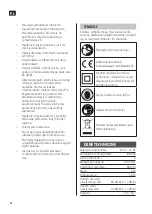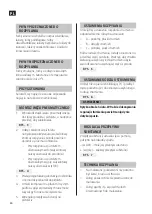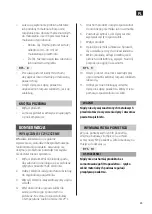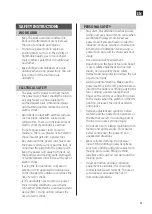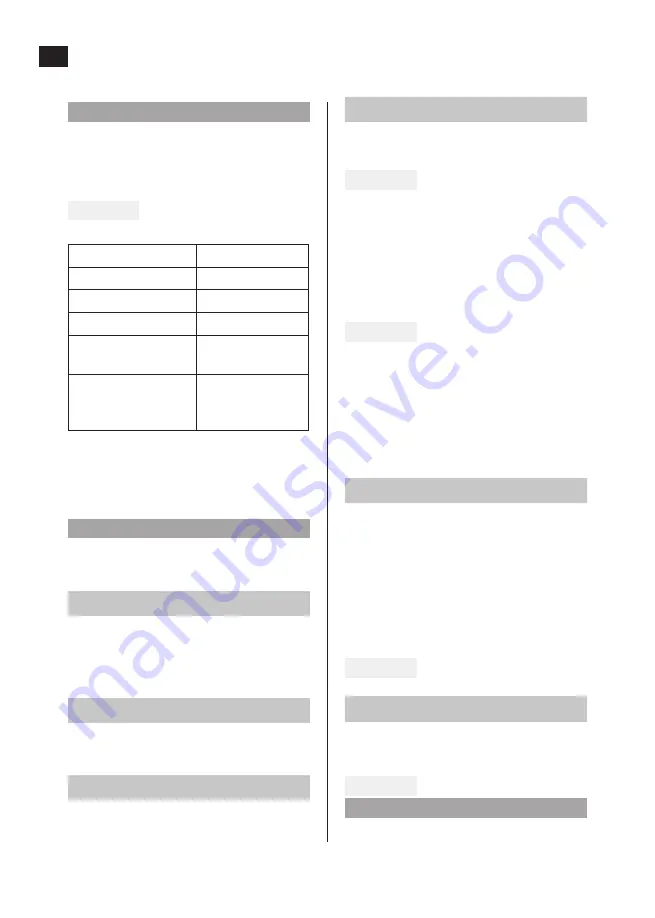
EN
30
FITTING THE AIR HOSE
1. Put the air hose connectors in the
connections on the product and on
the spray gun and twist to lock.
FIG. 3
2. Unscrew the container from the
spray gun. Adjust the suction hose.
The container should be almost
completely emptied during the spraying.
– When spraying downwards the suction
hose should point forward (A).
– When spraying upwards the suction
hose should be pointed back (B).
FIG. 4
3. Pour the prepared material into the
container and screw the container firmly
on the spray gun.
4. Put the compressor unit down on a level,
clean surface, otherwise it can suck in
dust etc.
5. Adjust the flow of material in the spray gun.
SPRAY SETTINGS
There are three different spray settings for
different applications.
• A = horizontal, flat jet
• B = round jet
• C = vertical thin jet
The different spray patterns are marked on the
front of the spray gun. Turn so that the arrow
for the required spray pattern is opposite the
projecting parts on the front end.
FIG. 5
ADJUSTING THE SPRAY PATTERN
Release lock ring (1) a little, twist the air nozzle
(2) to the marking for the required spray
pattern.
FIG. 6
WARNING!
Risk of personal injury. Never touch the
trigger while adjusting the air flow.
NOTE:
The material to be sprayed should always be
strained before use to remove any impurities
that can block the product. Impurities in the
sprayed material reduce the functionality of
the product and surface finish.
FIG. 2
Material
Run out time (s)
Enamel paint
25–45
Oil-based primer
30–50
Varnish
20–55
Varnish/flatting
varnish
25–40
Varnish stain
Sealing lacquer
Polyurethane
No thinner
The flash point of the material must be at
least 21°C.
Measure how many seconds it takes for the
material to run out (run time).
NOTE:
Stir the material well before measuring and
pour it into the test container.
LIQUIDS THAT CAN BE SPRAYED
Water and solvent-based paints, varnish,
primer, 2-component paint, clear varnish,
automotive paint, surface finish and wood
preservatives.
LIQUIDS THAT CANNOT BE SPRAYED
Emulsion paints, acidic or basic paints. Material
with a flash point less than 21°C.
PREPARATIONS
Check that the mains voltage corresponds to
the rated voltage on the type plate.
Summary of Contents for 014168
Page 2: ......
Page 5: ...1 9 3 4 5 6 7 8 10 11 1 2 ...
Page 6: ...2 3 4 A B ...
Page 7: ...5 6 A B C 8 B A 1 2 7 ...
Page 8: ...9 10 ...
Page 62: ......
Page 63: ......
Page 64: ......
Page 65: ......
Page 66: ......
Page 67: ......
Page 68: ......
Page 69: ......
Page 70: ......
Page 71: ......
Page 72: ......
Page 73: ......
Page 74: ......
Page 75: ......
Page 76: ......
Page 77: ......
Page 78: ......
Page 79: ......
Page 80: ......
Page 81: ......
Page 82: ......
Page 83: ......
Page 84: ......
Page 85: ......
Page 86: ......
Page 87: ......
Page 88: ......
Page 89: ......
Page 90: ......
Page 91: ......
Page 92: ......
Page 93: ......
Page 94: ......
Page 95: ......
Page 96: ......
Page 97: ......
Page 98: ......
Page 99: ......
Page 100: ......
Page 101: ......
Page 102: ......
Page 103: ......
Page 104: ......
Page 105: ......
Page 106: ......
Page 107: ......
Page 108: ......
Page 109: ......
Page 110: ......
Page 111: ......
Page 112: ......
Page 113: ......
Page 114: ......
Page 115: ......
Page 116: ......
Page 117: ......
Page 118: ......
Page 119: ......
Page 120: ......







